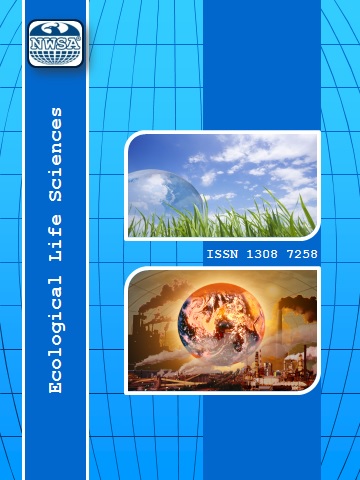References
[1] Grunwald, D.J. and Eisen J.S., (2002). Headwaters of the zebrafish emergence of a new model vertebrate. 3(9):717-724.
[2] Muller, B. and Grossniklaus, U., (2010). Model organisms - A historical perspective. J. Proteomics., 73(11):20542063. doi: 10.1016/j. jprot.2010.08.002.
[3] Atasayar, Z., (2011). Zebra baly?ynda (denio rerio) peroksiredoksin 6 geni rs 41055489 polimorfizminin antioksidatif göstergeler ve a?yr metal düzeyleriyle ili?kisi. Yüksek Lisans Tezi. Marmara Üniversitesi, Fen Bilimleri Enstitüsü, Ystanbul.
[4] Nusslein-Volhard, C., (2012). The zebrafish issue1 of Development. Development, 139(22):4099-4103. doi: 10.1242/dev.085217.
[5] Richard, J., Njiwa, K., Muller, P., and Klein, R., (2004). Life cycle stages and length of zebrafish (Danio rerio). Exposed to DDT Introduction, 50(3):220225.
[6] Boyle, D., Amlund, H., Lundebye, A.K., Hogstrand, C., and Bury, N.R., (2010). Bioavailability of a natural lead-contaminated invertebrate diet to zebrafish. Environ Toxicol Chem., 29(3):708714. doi: 10.1002/ etc.61.
[7] Leung, L.C., Wang, G.X., and Mourrain, P., (2013). Imaging zebrafish neural circuitry from whole brain to synapse. Front. Neural Circuits, 7:76. doi: 10.3389/fncir.2013.00076.
[8] Arrenberg, A.B. and Driever, W., (2013). Integrating anatomy and function for zebrafish circuit analysis. Front Neural Circuits, 7:74. doi: 10.3389/fncir.2013.000748.
[9] Kermen, F., Franco, L.M., Wyatt, C., and Yaksi, E., (2013). Neural circuits mediating olfactory-driven behavior in fish. Front Neural Circuits, 7:62. doi: 10.3389/fncir.2013.00062.
[10] Maaswinkel, H., Le, N., He, L., Zhu, L., and Weng, W., (2013). Dissociating the effects of habituation, black walls, buspirone and ethanol on anxiety-like behavioral responses in shoaling zebrafish. A 3D approach to social behavior. Pharmacol Biochem Behav., 108:16-27. doi:10.1016/j. pbb.2013.04.009.
[11] Morin, C., de Souza Silva, M.A., Muller, C.P., Hardigan, P., and Spieler, R.E., (2013). Active avoidance learning in zebrafish (Danio rerio) - the role of sensory modality and inter-stimulus interval. Behav Brain Res., 248:141-143. doi:10.1016/j.bbr.2013.04.009.
[12] Portugues, R., Feierstein, C.E., Engert, F., and Orger, M.B., (2014). Whole-Brain Activity Maps Reveal Stereotyped, Distributed Networks for Visuomotor Behavior. Neuron., 81(6):1328-1343. doi: 10.1016/j. neuron.2014.01.019.
[13] Goessling, W., North, T.E., and Zon, L.I., (2007). New waves of discovery: modeling cancer in zebrafish. J. Clin Oncol., 25(17):24732479.
[14] Moshal, K.S., Ferri Lagneau, K.F., and Leung, T., (2010). Zebrafish model: worth considering in defining tumor angiogenesis. Trends Cardiovasc Med., 20(4):114119. doi: 10.1016/j.tcm.2010.10.001.
[15] Ma, A.C.H., Guo, Y., He, A.B.L., and Leung, A.Y.H., (2011). Modeling tumor angiogenesis with zebrafish. In vasculogenesis and angiogenesis - from embryonic development to regenerative medicine. Chapter 7. Dan T. Simionescu and AgnetaSimionescuEds, 133-144. DOI: 10.5772/28763
[16] Howe, K., Clark, M.D., Torroja, C.F., Torrance, J., Berthelot, C., Muffato, M., and McLaren, S., (2013). The zebrafish reference genome sequence and its relationship to the human genome. Nature, 496(7446):498503. doi: 10.1038/nature12111.
[17] Flynn, E..J, Trent, C.M., and Rawls, J.F., (2009). Ontogeny and nutritional control of adipogenesis in zebrafish (Danio rerio). J. Lipid Res., 50(8):16411652. doi: 10.1194/jlr.M800590-JLR200.
[18] Ulloa, P.E., Iturra, P., Neira, R., and Araneda, C., (2011). Zebrafish as a model organism for nutrition and growth: towards comparative studies of nutritional genomics applied to aquacultured fishes. Rev Fish Biol Fish., 21:649666.
[19] Maddison, L.A. and Chen, W., (2012). Nutrient Excess Stimulates Cell Neogenesis in Zebrafish. Diabetes 61910:25172524.
[20] Yokobori, E., Azuma, M., Nishiguchi, R., Kang, K.S., Kamijo, M., Uchiyama, M., and Matsuda, K., (2012). Neuropeptide Y stimulates food intake in the Zebrafish, Danio rerio. J. Neuroendocrinol, 24(5):76673. doi: 10.1111/j.1365-2826.2012.02281.x.
[21] Ulloa, P.E., Medrano, J.F., and Feijoo, C.J., (2014). Zebrafish as animal model for aquaculture nutrition research. Front. Genet., 5:313. doi: 10.3389/fgene.2014.00313
[22] Dahm, R. and Geisler, R., (2006). Learning from small fry: the zebrafish as a genetic model organism for aquaculture fish species. Mar Biotechnol.(NY), 8(4):329345.
[23] Lieschke, G.J. and Currie, P.D., (2007). Animal models of human disease: zebrafish swim into view. Nature Reviews Genetics, 8(5):353-367.
[24] Willemsen, R., Hasselaar, W., Linde, H., and Van Der Bonifati, V., (2008). Zebrafish as a new model organism for Parkinsons disease. In Proceedings of Measuring Behavior. Spink AJ, Ballintijn MR, Bogers ND, et al. Eds. 5051.
[25] You, M.S. and Jiang, Y.J., (2007). Drug Discovery Using Zebrafish. Drug Discov.;12.
[26] Song, Z., Zhang, X., Jia, S., Yelick, P.C., and Zhao, C., (2016). Zebrafish as a model forhumanciliopathies. Journal of Genetics and Genomics. doi.org/10.1016/j.jgg.2016.02.001.
[27] Dede, K., (2020). Kontrollü laboratuvar ko?ullarynda zebra baly?y (Danio rerio, hamilton 1822) yapay üretimi ve cinsiyet orany. Yüksek Lisans Tezi, Yskenderun Teknik Üniversitesi, Fen Bilimleri Enstitüsü, Ystanbul.
[28] Çetinkaya, O., (2005). Balyk biyolojisi ara?tyrma yöntemleri. Ankara, Nobel Kitap, pp:239-276.
[29] Aryman, H. ve Aras, M.N., (2003). Çe?itli yem gruplarynyn alabalyk (Oncorhynchus mykiss, Walbaum, 1792) yavrularynyn büyüme performansyna ve et verimi özelliklerine etkileri. E.Ü. Su Ürünleri Dergisi, 20(3-4):405-411.
[30] Özdamar, K., (2001). Paket programlar ve istatistiksel veri analizi çok de?i?kenli analizler (4. Basky). Eski?ehir, Kaan Yayynlary.
[31] Jaya-Ram, A., Kuah, M.K., Lim, P.S., Kolkovski, S., and Shu-Chien, A.C., (2008). Influence of dietary HUFA levels on reproductive performance, tissue fatty acid profile and desaturase and elongase mRNAs expression in female zebrafish Danio rerio. Aquaculture, 277:275281. Doi:10.1016/j.aquaculture.2008.02.027.
[32] Diogo, P., Martins, G., Gavaia, P., Pinto, W., Dias, J., Cancela, L., and Martinez-Paramo, S., (2015). Assessment of nutritional supplementation in phospholipids on the reproductive performance of zebrafish, Danio rerio (Hamilton 1822). J. Appl. Ichthyol., 31(Suppl. 1):39. Doi: 10.1111/jai.12733.
[33] Gonzales, J.M.J., (2012). Preliminary evaluation on the effects of feeds on the growth and early reproductive performance of zebrafish (Danio rerio). J. Am. Assoc. Lab. Anim. Sci., 51(4):412417.
[34] Izquierdo, M., Fernandez-Palacios, H., and Tacon, A., (2001). Effect of broodstock nutrition on reproductive performance of fish. Aquaculture, 197:2542. doi:10.1016/S0044-8486(01)00581-6
[35] Paull, G.C., Filby, A., Giddins, H., Coe, T., Hamilton, P., and Tyler, C., (2010). Dominance hierarchies in zebrafish (Danio rerio) and their relationship with reproductive success. Zebrafish, 7:109117. doi:10.1089/zeb.2009.0618.
[36] Dabrowski, K., (1977). Protein requirements of grass carp fry (Ctenopharyngodon idella Val.). Aquaculture, 12:6367. Doi:10.1016/0044-8486(77)90047-3.
[37] Sotolu, A.O., (2010). Effects of varying dietary protein levels on the breeding performance of Clarias gariepinus broodstocks and fry growth rate. Livest. Res. Rur. Dev., 22, Article #6. Retrieved May 13, 2013. http://www.lrrd.org/lrrd22/4/soto22067.htm.
 +90(535) 849 84 68
+90(535) 849 84 68 nwsa.akademi@hotmail.com
nwsa.akademi@hotmail.com Fırat Akademi Samsun-Türkiye
Fırat Akademi Samsun-Türkiye
